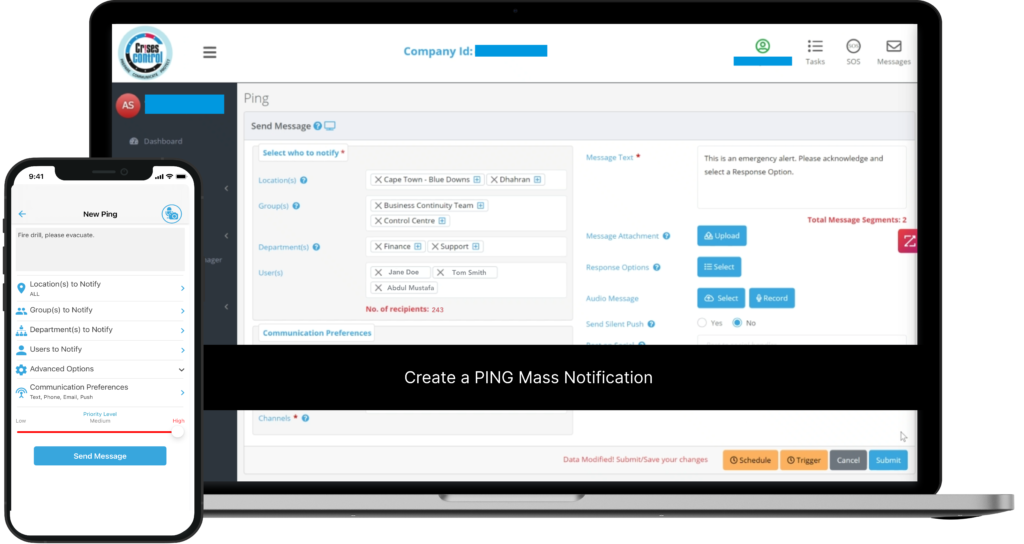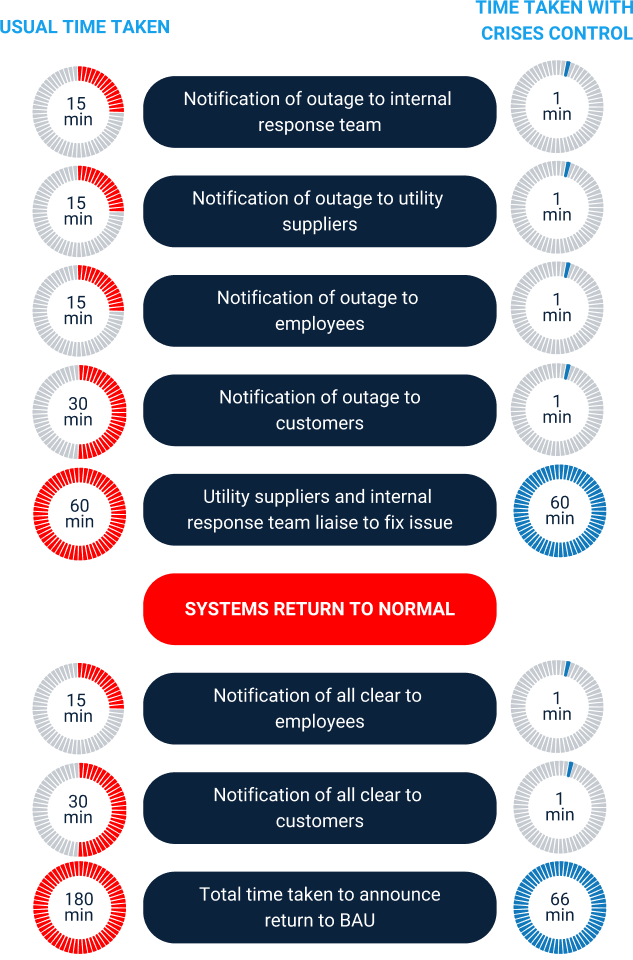Written by Anneri Fourie | Marketing Executive
Imagine a sudden crisis strikes your business—be it a natural disaster, a security threat, or a system failure—and the chaos that ensues due to slow or inefficient communication. In such high-stakes situations, the inability to quickly disseminate critical information can lead to severe consequences, from endangering employee safety to prolonged operational downtime. A mass notification system emerges as a crucial solution to this problem, ensuring rapid, efficient communication across your organisation when it matters most.
In this blog, we delve into a detailed cost-benefit analysis of investing in a mass notification system, highlighting both the financial implications and the significant advantages it offers for effective crisis management.
Understanding Mass Notification Systems
A mass notification system (MNS) is a platform designed to deliver critical information to a large audience quickly and efficiently. These systems utilise various communication channels such as SMS alerts, email notifications, mobile app alerts, and more. Mass notification systems are integral to crisis management, enabling rapid dissemination of vital information during emergencies like natural disasters, security threats, and other critical events.
Costs of Implementing a Mass Notification System
Initial Investment
Implementing a mass notification system involves several upfront costs. These include purchasing the necessary hardware and software, as well as installation and setup fees. Depending on the complexity and scale of the system, these initial expenses can vary significantly.
Ongoing Expenses
Maintaining an MNS requires ongoing investment. This includes costs for system maintenance and support, subscription or licensing fees, and regular training for employees to ensure they can effectively use the system. These expenses are crucial to ensure the system remains operational and effective.
Potential Hidden Costs
There are also potential hidden costs associated with integrating an MNS into your existing infrastructure. These can include customisation and scalability expenses to tailor the system to your specific needs and ensure it can grow with your business.
Benefits of a Mass Notification System
Now that we have covered the costs, let’s look at the benefits of a mass notification system and see how the cost is worth it.
Improved Communication Efficiency
One of the primary benefits of a mass notification system is the rapid dissemination of critical information. In a crisis, every second counts. An MNS allows you to communicate quickly and efficiently with your entire organisation, reducing response times and ensuring everyone is informed.
Enhanced Employee Safety
Employee safety is paramount. A mass notification system enables timely alerts during emergencies, helping to coordinate evacuation procedures and implement safety protocols. This can significantly reduce the risk of injury and ensure the well-being of your staff.
Business Continuity and Minimising Downtime
An effective MNS can help maintain operational continuity during crises by facilitating faster response times and minimising downtime. By keeping everyone informed and coordinated, your business can continue to function smoothly even in the face of disruptions.
Regulatory Compliance and Risk Management
Many industries have strict regulations regarding emergency communication and safety protocols. A mass notification system helps ensure compliance with these regulations, reducing legal and financial risks associated with non-compliance. This is particularly important in sectors such as healthcare, finance, and education.

Interested in Mass Notification Software?
Efficiently alert everyone in seconds at scale with our Mass Notification System – PING, get the message out fast and ensure rapid response and recovery.
Quantifying the Return on Investment (ROI)
To fully appreciate the value of a mass notification system, it’s essential to quantify the return on investment (ROI). By examining both tangible and intangible benefits, we can understand how an MNS not only covers its costs, but also adds substantial value to your organisation.
Measuring the Tangible Benefits
The tangible benefits of a mass notification system can be measured in several ways. For instance, reducing downtime during crises can lead to significant cost savings. Additionally, some businesses may see a reduction in insurance premiums due to enhanced safety protocols and improved risk management.
Evaluating Intangible Benefits
While harder to quantify, the intangible benefits of an MNS are equally important. Improved employee morale and trust can result from knowing their safety is a top priority. Additionally, enhanced company reputation and customer trust can lead to increased business opportunities and revenue.
Making the Decision: Is a Mass Notification System Right for Your Business?
Assessing Your Needs
Before investing in a mass notification system, it’s essential to assess your specific needs. Identify your communication and safety requirements, and evaluate your existing infrastructure and resources. This will help you choose the right system and ensure it meets your unique needs.
Weighing the Costs Against the Benefits
Using a cost-benefit analysis framework, you can weigh the costs of implementing a mass notification system against the benefits it offers. Consider both the short-term and long-term implications, and remember to account for both tangible and intangible benefits.
How Crises Control Can Help
Crises Control offers a robust mass notification system designed to meet the needs of modern businesses. Our platform provides rapid communication capabilities, ensuring your organisation can respond effectively to any crisis. With features like multi-channel alerts, real-time updates, and easy integration with existing systems, Crises Control helps you minimise downtime, enhance employee safety, and ensure regulatory compliance.
ROI with Crises Control
Investing in Crises Control’s mass notification system offers significant ROI. Our clients have reported substantial cost savings from reduced downtime, improved employee morale, and enhanced reputation. Additionally, the peace of mind that comes from knowing your organisation is well-prepared for any emergency is invaluable.
Here is a closer look at the ROI with Crises Control:

Conclusion
We’ve explored the comprehensive costs and substantial benefits of investing in a mass notification system. From understanding the initial investment and ongoing expenses to recognising the invaluable benefits such as improved communication efficiency, enhanced employee safety, and business continuity, it’s clear that a mass notification system is a vital component of effective crisis management. The tangible and intangible returns on investment underscore the importance of having a robust MNS in place.
In today’s unpredictable business environment, ensuring the rapid dissemination of critical information is crucial for protecting your employees and maintaining operational continuity.
Ready to enhance your crisis management capabilities? Contact us today to get in touch with an expert and learn how Crises Control can help your business. Our team is here to guide you through the process and provide a free personalised demo, so you can see firsthand how our mass notification system can benefit your organisation.
Request a FREE Demo









